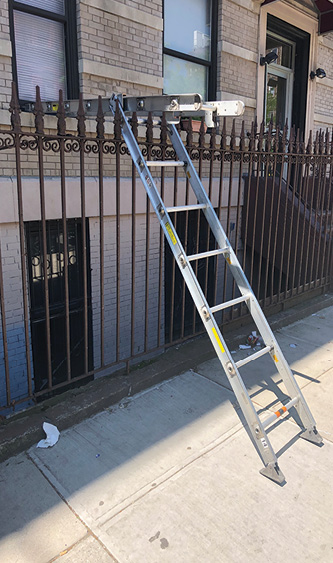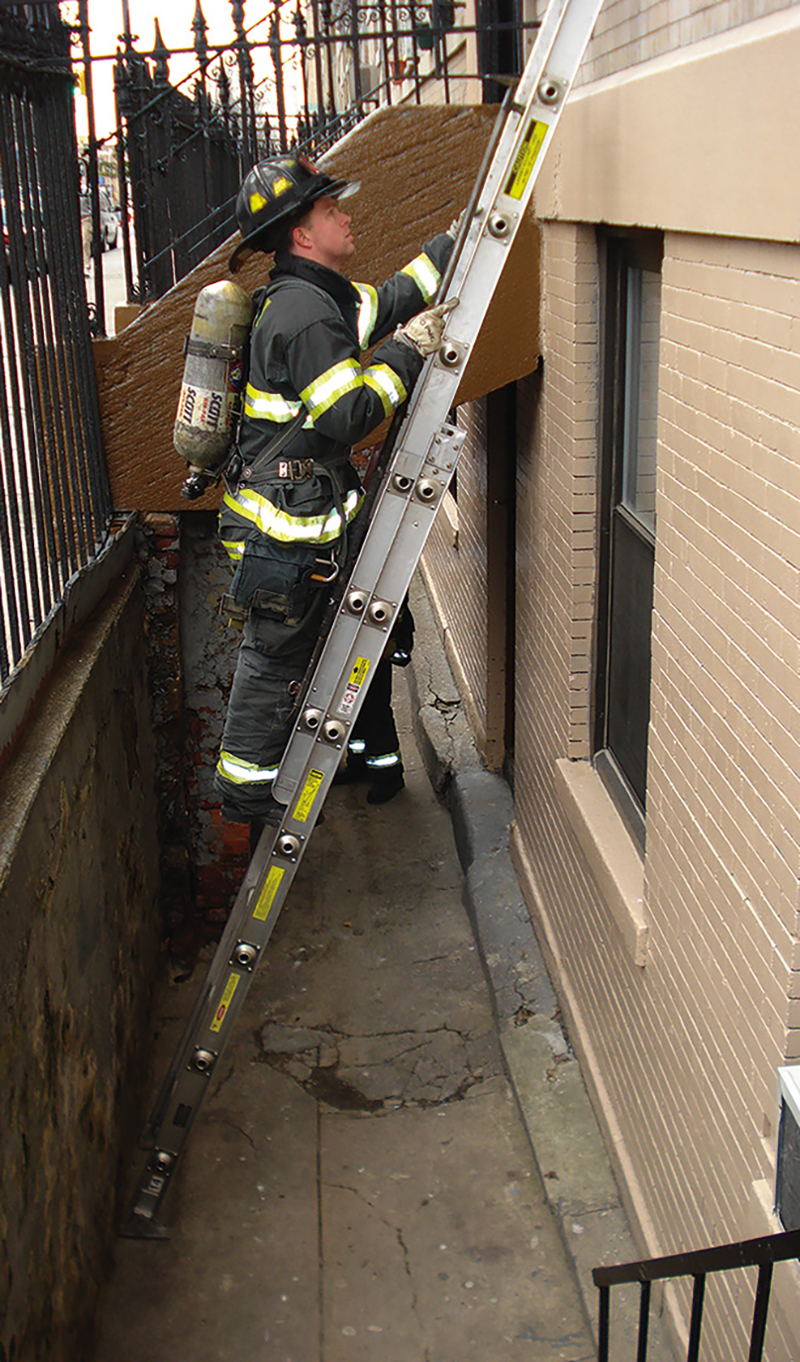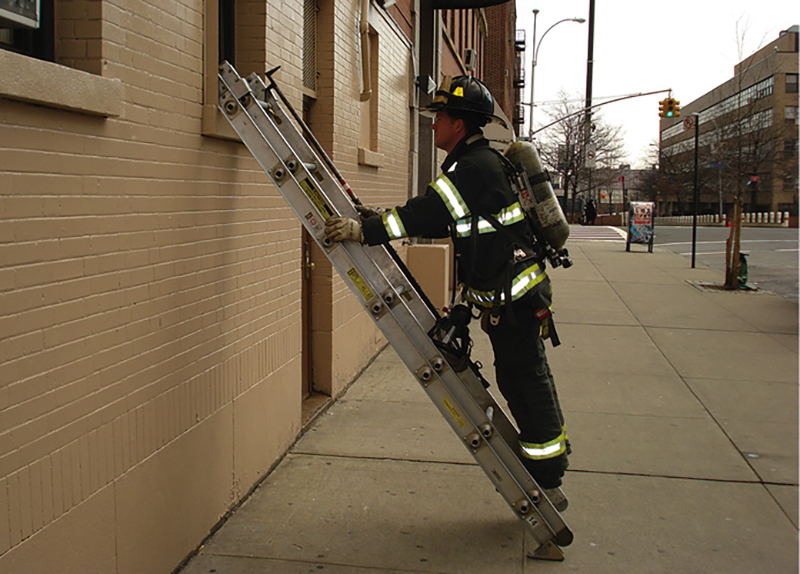Throughout cities and towns across the country, firefighters will encounter sunken courtyards, step-down alleys, sloped yards, and structures with walk-out basements that now make the first floor the second in the rear or side yard. In many cities, block-long buildings may have a depressed narrow alley in front, which usually provides access to the basement apartment, boiler room, utility room, and rear or side yards. Firefighters have nicknamed the depression in front of many tenements or multiple dwellings “the moat.” These depressions are deeper than just the step or two down often found at brownstone-type structures. Blocks upon blocks can have buildings with these characteristics, and it’s also common to find just one in a row or an isolated building with this feature.
The moat is usually protected by a large wrought iron fence anywhere from six to eight feet high, which often has spikes, blunt square ends, or some type of ornamental tips on the upright balusters. The iron fence safeguards people walking on the sidewalk, preventing them from falling into the yard below. To maintain it in a stable position, it may have support rods or braces that connect to the front wall of the structure. If the fence runs a long distance, firefighters can expect to see more support mechanisms than if it was just a couple of feet long.
Another common feature of this fence is the hinged gate usually located at one end that provides access and egress into the moat. The gate may have many types of locking mechanisms such as a panic bar lock, slide bolt, regular doorknob, deadbolt, or more substantial padlock and chain providing security to the building. Firefighters can also expect to find many of these gates covered with wire mesh, expanded metal grating, solid steel plating, or additional security measures to keep intruders out.
RELATED FIREFIGHTER TRAINING
- Tactical Operational Tips in Laddering
- Training Minutes: Raising a Ladder: Body to the Building
- Training Minutes: Moving Portable Ladders
In the Fire Department of New York, most truck companies carry a homemade bent rebar tool for these fences and gates, to easily open the gates’ panic bar lock without damaging the gate or lock. The tool is shaped like a large “Z” or “L,” and you slip the longer portion of the rod into a slot in the wire grating and then lower it toward the panic bar. As the rod gets near the panic bar, you pull back on the handle portion. The force of the rod hitting the release and your pulling on the handle opens the gate. It is important to always carry the rebar tool with you while proceeding through the depressed alley to the rear yard. There may be other similarly locked gates around the building. If you encounter other means of security, you’ll have to revert to conventional forcible entry techniques or use the power saw to gain access to the lower level (photos 1 and 2).

(1) The rebar tool is simple to make out of rebar or a solid rod. Make sure it’s thin enough to fit through grating. (Photos courtesy of Brian Doyle.)

(2) Having the rebar tool readily accessible allows you to gain access through a gate more quickly.
Pulling up to a working fire with a victim trapped in a first-floor window is usually an easy removal for the truck company outside team. However, when encountering the high iron fence, you will have to overcome this obstacle to make the rescue with a portable ladder. Often, you will immediately think that grabbing the forcible entry saw and cutting the fence for access to the victim is the answer. Unfortunately, cutting out a section of the fence may be very difficult. You may not be able to remove the cut section because the support rods and bracing are keeping the fence in place. You may also have to cut these rods to allow the fence to drop down into the moat.
Using the saw to cut the fence and supports takes a lot of time, something we’re short on. Once the fence drops down, use caution to not fall several feet down into the moat while positioning the ladder to the building. Plus, if the fencing drops downward in a vertical position or is leaning into your work area, the spiked ends of the balusters can be a danger to you and victims in the vicinity. When faced with this scenario, an immediate rescue is needed, so don’t plan on cutting a fence as your first tactical choice.
Don’t think about using the tower ladder bucket or an aerial ladder to access the victim. The boom and aerial on these devices won’t reach the victim in the first-floor window because of the height of the fence. Plus, you have to set up the rig; even if you’re only throwing the work-side outriggers down, you better hope there’s enough room to fully extend them. With today’s new apparatus, the computer may shut down the operation even if the operator engages the override feature. In addition, if the building sits close to the road, the aerial or tower might not be able to make the swing over to the building. Pushing the fence down with the aerial or tower ladder is not an option—the fence could buckle, snap, or bend, causing damage to the apparatus, building, or victim or impeding access to the victim.
Portable ladders are exactly what the term means—portable. They are easy to carry, move, or transport to be raised to provide a means for rescue, access, and egress. Consider them the fastest type of ladders to deploy on the fireground.
When encountering these fences, realize that attempting to throw an extension or roof ladder over the top of the fence to the first-floor window puts it at the wrong angle. The tip of the balusters will also be protruding through the rungs, making it difficult to climb or reach the victim. It also makes it very hard to reposition or move the ladder once it gets wedged between the balusters.
Quick Solution: A-Frame Combination Ladder
An easy and quick solution for laddering the first floor when faced with an iron fence is using the A-frame combination ladder. Don’t deploy this ladder from the sidewalk and over the fence in a cantilever position. The ladder will be very difficult to climb, transverse, and operate from when in this position. It could also slide off the windowsill when you and the victim are moving on it. If it slides off the sill, you both could plunge downward into the moat and be injured (photo 3).

(3) Placing the combination ladder in this position is not a good idea. The ladder could slide off the sill or get wedged on the fence’s balusters when you try to position it.
The simplest way to deploy the A-frame combination ladder is from the base of the moat. Because of this ladder’s compact size (seven feet in the closed position) and light weight (35 pounds), you can easily transport it in either the vertical or horizontal position. Its compact size also allows you to maneuver it through the fence’s gate, under a front stoop, around garbage and recycling cans, and through an enclosed alley to a shaftway or rear yard.
When transporting the ladder, always use caution when walking under the front stoop or in an enclosed alley; there may be limited head clearance, especially when wearing your helmet. Also, when walking past garbage bags and cans and recycling bins, be aware that the ground could be very slippery from spilled fluids.
Another value of this ladder over the folding ladder (also known as the suitcase, scissor, and attic ladder) is that it extends to various heights. The folding ladder, once placed in the opened position, only has one set height (photo 4).

(4) Use caution walking around garbage and recycling cans. The ground could be slippery from spilled oils and liquids.
After you have gained entry through the fence’s gate and transported the ladder down the stairs into the moat, you can raise it to the victim. When raising the A-frame ladder, resist the urge to grab an upper rung on the fly section of the ladder and raise it straight up. If your combination A-frame is equipped with permanent ladder-lock brackets, they will strike the bed section of the ladder when you raise the ladder with this method. If your ladder is equipped with the standard locks and pawls, still resist the urge to grab an upper rung. Because of body mechanics, you will only be able to get so much height out of the raise when grabbing an upper rung.
To get the most range of motion with your body and the ladder, grab the lowest rung possible on the fly section with an underhand grip. Then, slightly raise the fly section upward, releasing the securing brackets from the first rung.
Once you have cleared the brackets, slightly tilt the base of the fly section of the ladder outward and away from the bed section, which keeps the ladder’s permanent locking brackets from striking any rung on the bed section during the raise. You can now raise the ladder to the desired height to make the removal. During the raise, maintain a hold on the back of the bed section’s rail with your opposite hand to stabilize the ladder.
Once you have locked the ladder’s rungs into position, you can use the moat’s foundation wall to foot the ladder, preventing the base from slipping out of position. As in all ladder raises, size up the victim’s emotional state and physical positioning. You may have to raise the ladder a short distance away so the victim isn’t grabbing for it and then slide it into position for the removal. If the person is hanging out of the window, with legs dangling, slide the ladder upward under his feet so he can get some support from the ladder.
When you climb the ladder, you may have to get onto the ladder from the side. With the butt of the ladder positioned up against the foundation wall, you may not be able to climb up from the lowest rung wearing self-contained breathing apparatus (SCBA) in the limited space. Also, when coming down, you won’t be able to step off at the bottom rung and you’ll have to step off to the side. Since victims won’t have on SCBA, they can usually maneuver off the ladder even with the wall there. However, always ensure you support them until they’ve stepped down onto the ground (photo 5).

(5) Once you have butted the ladder up against the foundation wall, you can climb it.
Realize when encountering a moat that the first floor is going to be higher than anticipated and not level with the ground. A first-floor fire in the side or rear yard is most likely going to look like it’s on the second floor and the windows that are on the first level are for the basement. If you travel down into the moat from grade level and experience fire or smoke out the windows one level up, communicate that the fire is on the first floor and not the second floor. Miscommunication has occurred in these situations and can create problems for firefighting operations.
Maintaining situational awareness is key when operating at any incident. Luckily, you can transport the combination A-frame ladder down through the moat or through the interior lobby to an exit door under the main stairs to the side or rear yard. Just make sure the first-floor fire apartment door is controlled and the companies know of your intentions.
Once down to the ground level, you can now ladder the first floor easily from the ground for vent-enter-search operations or for a portable ladder removal. In some circumstances, the grade level may even decrease more, but since the A-frame is 14 feet when open, you can still use it to ladder the first floor. In some situations, depending on the grade level, the ladder may even be able to reach the second-floor windows, which may look like the third floor from ground level (photo 6).

(6) You can use the combination A-frame ladder in a closed or extended position when you encounter first-floor windows of varying heights.
You shouldn’t use the combination A-frame ladder only for controlling a discharging sprinkler pipe’s head or working on a light ballast in a commercial occupancy. The ladder offers many advantages when you encounter moats, sunken yards, and lower grades. Working and drilling with this ladder at the various buildings in your response area will enhance your knowledge of its value on the fireground.
MICHAEL N. CIAMPO is a 36-year veteran of the fire service and a lieutenant in the Fire Department of New York. Previously, he served with the District of Columbia Fire Department. He has a bachelor’s degree in fire science from John Jay College of Criminal Justice in New York City. He is the lead instructor for the FDIC International Truck Essentials H.O.T. program. He wrote the Ladders and Ventilation chapters for Fire Engineering’s Handbook for Firefighter I and II (Fire Engineering, 2009) and the Bread and Butter Portable Ladders DVD and is featured in “Training Minutes” truck company videos on www.FireEngineering.com.
Michael N. Ciampo will present “Truck Company Essentials” on Monday, April 25, and Tuesday, April 26, 8:00 a.m.-5:00 p.m., and “Tower Ladder Tactics and Tips” on Thursday, April 28, 1:30 p.m.-3:15 p.m., at FDIC International 2022 in Indianapolis.

